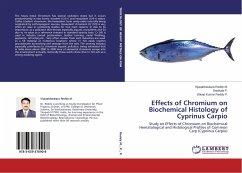The heavy metal Chromium has several oxidation states but it occurs predominantly in two forms: trivalent (Cr3+) and hexavalent (Cr6+) states. Unlike trivalent chromium, the hexavalent form rarely exists naturally being originated by anthropogenic sources. Hexavalent chromium (Cr (VI)) is very often an issue in ecotoxicity studies for two main reasons: (i) due to its importance as a pollutant that threats especially aquatic ecosystems and (ii) due to its value as a reference toxicant in standard toxicity tests. Cr (VI) is used in industry (wood preservation, leather tanning, metal finishing, pigments, refractory,etc., Very often wastes from such industries are used as a fill material at numerous locations where Cr (VI) easily reaches groundwater by leaching and seepage from the soils. The tanning industry especially contributes to chromium aquatic pollution, being estimated that in India alone about 2000 to 3200 tone of elemental chromium escape into the environment annually. Generally these works show that Cr (VI) acts as a strong oxidizing agent.
Bitte wählen Sie Ihr Anliegen aus.
Rechnungen
Retourenschein anfordern
Bestellstatus
Storno

